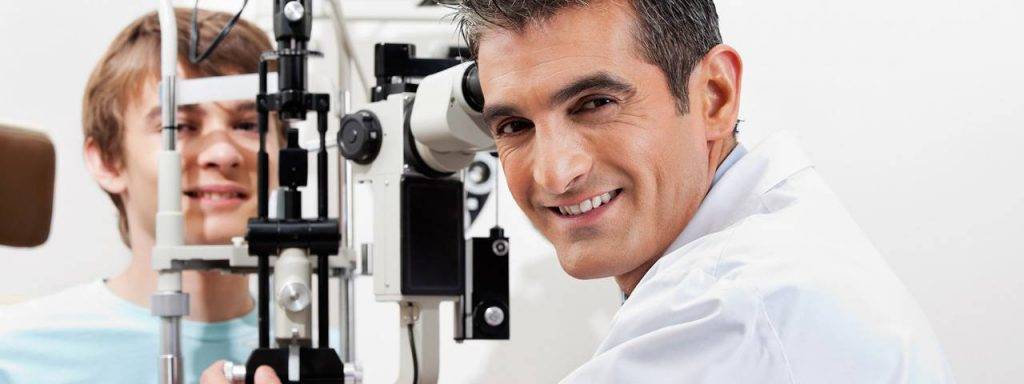What is an eye emergency?
An eye emergency is any situation that poses a threat to a child’s eye health or vision.
- Eye injuries account for over 1.5 million visits each year to the emergency room.
- Children, from infancy to age 17, represent over 340,000 (22%) of all hospital admissions as a result of an eye injury.
An eye injury can be very painful and require emergency medical treatment. Contact your eye doctor or general physician immediately if your child experiences trauma to the eye or any of the listed signs below.
Common eye injuries that require immediate medical attention
- Eye swelling or bruising around the eye can result from an eye infection, trauma to the eye, or significant allergic reactions. While you should immediately place an ice pack on your child’s eye, you must also contact your eye doctor to examine the nature of any damage to the eye.
- Inflammation of the iris (traumatic iritis) can result from being hit in the eye, and can result in permanent vision loss.
- Bleeding inside the eye (hyphema) in the space between the cornea and iris can result from an orbital blowout fracture, when there is a break in the facial bones around the eye— caused by a blow to the eye and face, such as from being punched, kicked, or hit by sports equipment.
- Deep puncture wounds can result from a foreign object that has penetrated the eye, such as a piece of glass or metal. Any pieces of a foreign object must be removed from your child’s eye to prevent serious eye damage and vision problems.
- Corneal abrasions (eye scratches) can result from rubbing the eye while something is stuck inside, scratching the eye while inserting/removing a contact lens, or simply being poked in the eye. Bacteria and fungus can enter the eye through a scratch, especially if the object that caused the scratch was unclean, making the eye more susceptible to an infection. While a minor scratch might not seem to need immediate medical care, a visit to the eye doctor is still important to prevent an eye infection.
- Corneal lacerations are a partial or complete cut through the cornea. Lacerations can result from rubbing your eye too hard, wearing old contact lenses, flying objects that strike the eye such as wood or metal, or even from a paper cut to the eye if enough force is used. Immediate medical attention is required and treatment usually involves surgery to remove any foreign objects.
- Chemical substance burns can cause mild to severe problems, depending on the type of chemical. Acid chemicals can cause significant burning and redness. Alkali chemicals such as oven and toilet cleaners, can cause more serious damage, including blindness. Any chemical that splashes into the eyes needs immediate medical care to prevent loss of vision.
Common signs of eye emergencies
If you notice ANY of these signs, please seek EMERGENCY medical attention:
- Sudden vision changes, in one or both eyes
- Appearance of blood on or inside the eye
- Burning sensation around the eye
- Foreign object stuck in the eye
- Pain
- Double vision
- Seeing flashes of light
- New sensitivity to light
- Sudden changes in pupil size
- Floaters
- Dark shadows blocking vision
Bleeding on the surface of the eye (subconjunctival hemorrhages) can occur when a blood vessel breaks and leaks fluid. The blood vessel, which is located between the white of the eye (sclera) and it’s clear covering (conjunctiva), causes either part of the eye, or the entire eye to look red.
While this appears very serious, it is fairly common, and does not cause any pain or damage to the eye. The eye will typically return to a normal appearance over the course of several weeks, without any treatment.
Caution: Do not self-diagnose— any time blood is noticed on the eye, seek urgent medical attention.
Causes of eye injuries
Children are vulnerable to eye injuries because they are involved in active play and sports on a regular basis— and most of the time, lack the essential awareness for injury prevention.
Most eye injuries in children are are caused by:
- Rough play
- Head collisions
- Contact sports
- Ball games
- Projectiles
- Fireworks
- Sharp points
- Aerosols
- Hot water burns
- Household chemicals
- Accidents with tools or office supplies
Contact an eye doctor immediately if your child experiences trauma to the eye or any of the listed signs above.
SEE RELATED: Top 5 Pediatric Eye Emergencies
Are all toys safe for children?
No.
According to the U.S. Consumer Product Safety Commission, in 2017, toy related injuries to the head, face, and eyes, caused up to 252,000 visits to the emergency room:
- 69% were children ages 12 and under
- 36% were children under five
Common toy-related eye injuries:
- Corneal abrasions
- Corneal ulcers
- Traumatic cataracts
- Retinal detachment
- Internal eye bleeding
While a corneal abrasion can be a minor scratch to the eye, it can also be severe. The other common injuries can cause significant vision problems, even total loss of vision.
Which toys are dangerous?
- Guns that shoot any type of projectile, dart or “missile” are popular toys, but buyers beware! Even if the gun shoots water or a soft foamy dart, most toy guns can shoot at a fast enough speed to cause real harm— even with water or a piece of foam.
- Sharp pointed objects such as sticks, swords, sabers, wands, bayonets, fishing poles, etc. Even if made of soft material, any sharp point can still cause an eye injury.
- Aerosols contain chemicals that can cause irritation to the eye and even chemical burns! This “toy” can also scratch the eye and cause eye infections.
- Bright flashlights and laser pointers contain a high light intensity that when used inappropriately, is dangerous enough to cause temporary or even permanent vision loss!
How can you protect your child from an eye injury?
Many childhood eye emergencies can be prevented with appropriate care and planning.
Consider these few basic rules to help lower your child’s risk of an eye injury:
- Educate children about eye injury risks at school, home, and during play.
- Place any household chemicals and dangerous items such as scissors, staples, push pins, etc. out of your child’s reach.
- Recognize that the kitchen is a dangerous place for children— keep all dangerous objects such as hot water, knives, electrical appliances, heavy pots , etc. out of your child’s reach.
- Supervise your child whenever possible and teach them the importance of wearing protective eyewear during certain activities.
- Inform older children about risky behaviors such as tobacco use and playing with fireworks.
Preventing eye injuries during sports
Sports and leisure activities are the most common cause of pediatric eye injuries.
Less than 15 percent of children wear any form of eye protection when participating in activities that can cause eye injuries.
Most sports-related eye injuries can be prevented through the use of protective eyewear such as sports goggles, wrap-around polycarbonate lenses, or side shields.
You may have seen basketball players wearing these types of frames. Protective eyewear can be purchased with prescription lenses so children can see clearly while playing their favorite sport, without the risk of getting injured.
Protective eyewear is essential for all sports such as hockey, basketball, football, soccer, baseball, tennis, and any other sport where the athlete is in motion. Regular eyeglass frames will not provide enough protection and can easily be damaged.
What should you do in an eye emergency?
Contact an eye doctor or family physician immediately.
Most doctors have emergency numbers that you can use after hours, or on weekends. If you cannot reach your doctor, go straight to the nearest emergency room.
The earlier your child is seen by a medical professional, the higher their chances will be for optimal treatment results.
LEARN MORE: Guide to Pediatric Eye Conditions
Schedule an appointment with an eye doctor for a comprehensive eye exam, and to discuss any questions you may have about treating your child’s eye condition.


